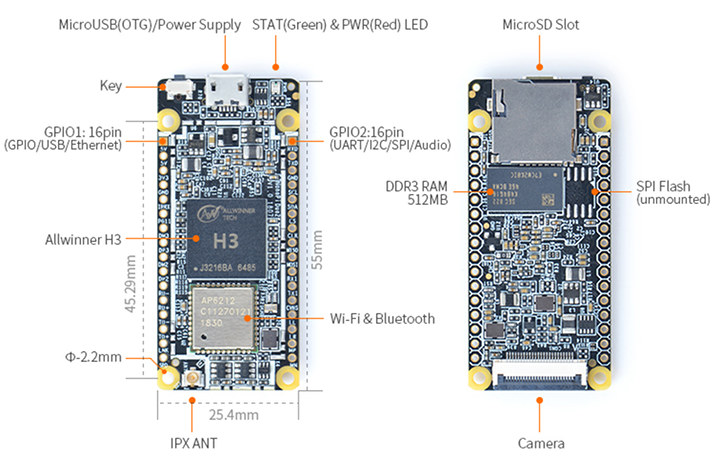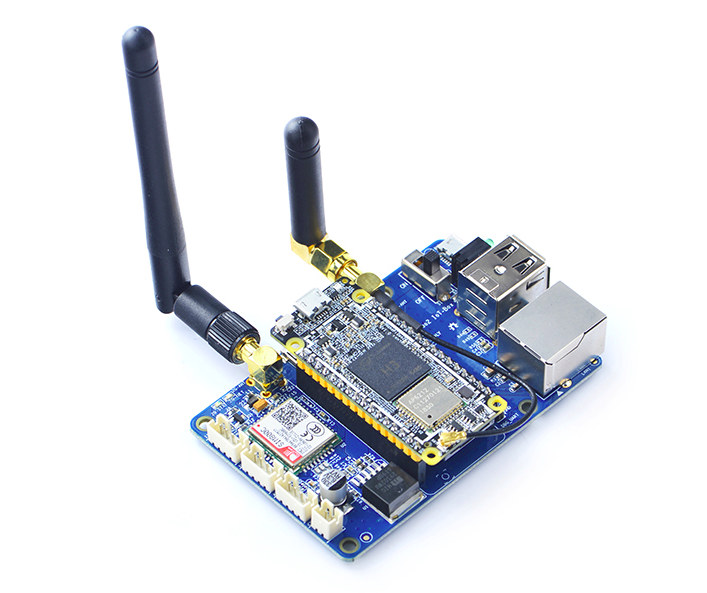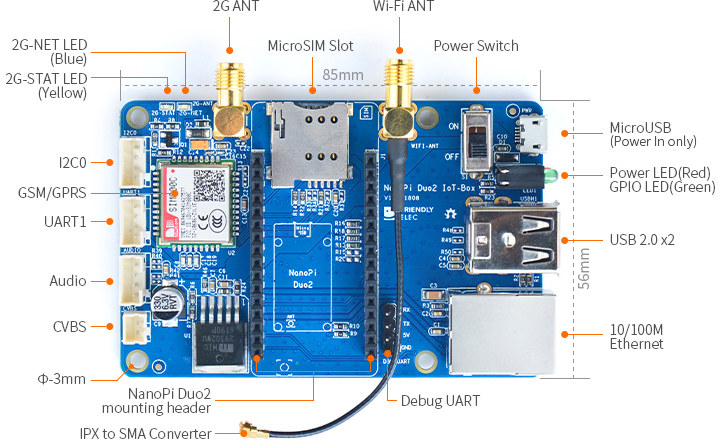NanoPi Duo was launched last year as an ultra-cheap ($8+) Arm Linux board that fits into a breadboard. The board was powered by Allwinner H2+ processor coupled with 256 or 512MB RAM, and the infamous XR819 802.11b/g/n WiFi chip.
FriendlyElec has now launched NanoPi Duo2, that’s still breadboard compatible, but with a slightly longer form factor, Allwinner H3 processor, 512 MB RAM, better WiFi thanks to an AP6212 module, and an extra camera interface. As we’ll see further below the company also developed a carrier board for 2G cellular IoT applications.
 NanoPi Duo2 specifications with highlights in bold showing differences again NanoPi Duo:
NanoPi Duo2 specifications with highlights in bold showing differences again NanoPi Duo:
- SoC – Allwinner H3 quad core Cortex A7 processor @ 1.2 GHz with Mali-400MP2 GPU
- System Memory – 512 MB DDR3 SDRAM
- Storage – micro SD card slot, footprint for SPI flash
- Connectivity – 802.11 b/g/n WiFi + Bluetooth 4.0 LE (Ampak AP6212 module) with
chip antenna, andu.FL/IPEX connector for external antenna - USB – 1x micro USB OTG port
- Camera I/F – Connector for OV5640 camera
- Expansion headers – 2x 16-pin breadboard compatible headers with 2x USB host ports, GPIO, UART, SPI, I2C, MIC, Line Out, CVBS (composite video), Ethernet, 5V, 3.3V, and GND
- Misc – 1x key
- Power Supply – 5V/2A via micro USB port
- Dimensions – 55 x 25.4mm (Duo is 50mm long)
- Weight – 7.36 grams without headers
- Temperature Range – -40°C to +80°C
The company provides binaries and source code for U-boot, Linux Kernel 4.14, and Ubuntu 16.04.2 LTS (Xenial). All you need should be in the Wiki.

As noted the in the introduction, the company also design the “IoT-2G carrier board” (aka NanoPi Duo2 IoT-Box) for the new board specifically for 2G Cellular IoT applications. The carrier board includes:
- On-board SIM800C quad-band GSM/GPRS module + micro SIM slot
- Antenna Connector – WiFi & 2G SMA connectors
- USB – 2x USB Host
- Connectivity – 10/100M Ethernet
- Expansion Headers (2.0mm pitch)
- Serial header (UART1)
- I2C header
- Audio input and output header
- CVBS (composite video) header
- Debugging – 4-pin UART header
- Misc – Power switch, 2G Network and status LED’s, power and user LED’s
- Power Supply – 5V via Micro USB power input
- Dimensions – 85×56 mm
 The board has its own dedicated Wiki page for more hardware information, and simple quick start guides for GSM connectivity, audio recording and playback, and USB Dot matrix displays.
The board has its own dedicated Wiki page for more hardware information, and simple quick start guides for GSM connectivity, audio recording and playback, and USB Dot matrix displays.
NanoPi Duo2 has just launched for $19.50, and the NanoPi Duo2 IoT-Box with WiFI/Bt and GSM antennas adds another $10 to the total. As usual when it comes to 2G cellular connectivity, you should make sure your provider / country is not about to phase it out, since what is referred to as “2G sunset” has already happened in several countries.
Thanks to theguyuk for the tip.

Jean-Luc started CNX Software in 2010 as a part-time endeavor, before quitting his job as a software engineering manager, and starting to write daily news, and reviews full time later in 2011.
Support CNX Software! Donate via cryptocurrencies, become a Patron on Patreon, or purchase goods on Amazon or Aliexpress. We also use affiliate links in articles to earn commissions if you make a purchase after clicking on those links.





> Linux Kernel 4.11.2
Fortunately this is wrong, FriendlyELEC already moved on to 4.14 (LTS).
BTW: that’s also where I spotted this board the first time (back then planned with RTL8189 just like on early NEO4 PCB revisions): https://forum.armbian.com/topic/8031-nanopi-duo2-and-nanopi-hero-are-coming/
I’m curious as to who is dumb enough to buy a product with 2G/GSM only any more. More and more networks are being closed in favour of freeing up the frequencies for 4G, which means that within a couple of years at the most, these things will be useless. Even some 3G networks are being shut down already, so if it doesn’t have 4G, what’s the point of wasting money on it?
Isn’t there a difference between 2G voice and data services? At least according to http://maps.mobileworldlive.com countries where 2G networks have been shut down officially coverage is quite ok to excellent.
And I wouldn’t consider 10 bucks ‘wasted money’ if it serves a purpose even for just a few months/weeks.
https://1ot.mobi/blog/2g-and-3g-networks-are-shutting-down-globally
Obviously it varies, but it would also seem that 3G is going to die quicker in some places than 2G, as suggested in that article. But assuming that article is correct, anyone in the US, Canada (except one network), Australia, Korea, Japan, Singapore and Taiwan shouldn’t bother.
Look, I’m not saying 2G is bad, in fact, for coverage, it’s the best standard, but it’s eating up a lot of frequency space and the networks are the ones that want to re-deploy those frequencies using shorter range, but more data efficient technologies. I guess this is why we got crap like NB-IoT and other various LTE standards for “IoT” type devices.
I just think it’s a bit crazy to launch new 2G devices and to consider developing software for a 2G network device.
> it’s eating up a lot of frequency space and the networks are the ones that want to re-deploy those frequencies using shorter range, but more data efficient technologies
Sure, but from a consumer point of view if 2G is still there and can be used within the next 12 or 24 months why not spending the additional 10 bucks for this module then and upgrading to a future “IoT-4G carrier board” in 2 years when prices came down already?
It’s a modular approach here and not something like the infamous Orange Pi nG-IOT series (all using totally different SoCs and therefore also software stacks)
Most (all?) US networks will not process a new 2G activation. 2G is only being maintained in order to facilitate migration of existing devices off from it.
The SIMCom modules have interfaces in common (AT command set); such software could (probably) be adapted without too much trouble, I think.
Somebody told me 2G would not go anywhere in Europe, because e-call (automated emergency calls for cars) was mandated by the EU, and worked over 2G. I never really looked into the details of that claim.
I heard something exactly like this a while ago, that there are sensitive equipments in the wild relying on 2G that prevent it from going away. It’s possible however as Jon suggests, that they will refuse new subscriptions without a compelling reason (plugging your shiny new friendlyelec board might not necessarily apply :-)).
Whats the advantage of H3 over H2+ in headless applications?
I’m just wondering why FriendlyElec decided to use more expensive CPU.
Fortunately they dropped the Allwinner XRadio shit.
IKR? I kind of gave up in disgust at least initially on trying to add an XR819 driver bitbake for Yocto a while back because it’s craptastic. X-D
I’ve added support for this in my meta layer here:
https://layers.openembedded.org/layerindex/branch/master/layer/meta-allwinner-hx/
2g and 3g can be accommodate on 4g
in some areas. I wonder if the carrier board is intended to be swapped for a 3g or 4g board latter on.
Might have changed
https://www.capacitymedia.com/articles/3735675/Exclusive-Vodafone-will-not-switch-off-2G-until-2025
But will Vodafone active new 2G devices? Doesn’t do any good if they won’t let you connect to it.
Good question, I do not know the answer.
Meh, it’s not like it’s going to be staying all over the world. There’s the rub there. You need to have an option path that offers upgrades to 4G, eventually 5G. Even if you’re not doing a lot of data, they want the old tech to DIE because it’s not an efficient use of spectrum.
My take’s like Icenowy. At least they didn’t put the craptacular XR819 on the thing like the prior micro boards from them and the other usual suspects in this space did. It made the devices much less useful. The Cypress Semi (Formerly Broadcom) device needs only a good Device Tree entry for it’s SD host controller and power up sequencing and it just simply works and well for 2.4Ghz as an abgn device. The BT support works nicely if you have the same for the UART that it’s attached to turned on. (For those not using their Ubuntu Core offering and building your own or using Yocto, there’s a bit of a set of steps FriendlyElec does to get it working right that the hints to do the same sort of thing on your own with the chips (or if you’re using Yocto, just grab the layer) in my metadata layer for my personal projects.
https://github.com/madscientist42/meta-pha
I don’t see a chip antenna in the photo. It looks like that might be another difference with the Duo1; the Duo2 might require an external antenna.
That’s more like a project BoM dependency detail there. The Chiptennas on many of these devices aren’t all that great overall- and it’s just a U.Fl pigtail away from real antennas, including peel-n-stick’s.
Quite a few applications use 2G to transfer data only and it is very cheap. For these applications if they use a 3G or 4G module the cost will be much higher
5mp camera module for duo 2 now available
Does this board FCC or CE certified….?
Hi, I am looking for this modules, do you received any info about the certification – FCC, CE